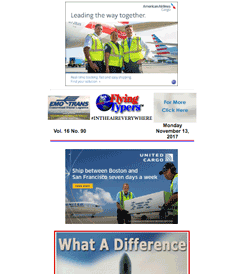
Last week Messe München,
the folks that bring you Air Cargo Europe every other year, once again
organized Logitrans International Transport Logistics Exhibition in Istanbul
in conjunction with EKO Fair Limited, Munich.
Traditional air freight forwarders are
being challenged by new ‘digital’ market entrants across their
service portfolios.
The start-ups come in many guises. Some
market themselves as cloud-based e-forwarders, brokers, or online sales
platforms.
Others manage rates and data, sell information,
and/or offer predictive logistics services.
But what sort of threat do they really
pose to incumbent forwarders?
What the new entrants usually have in common
is a firm belief they can reduce costs and improve efficiency for customers
when compared to traditional forwarders, who they often characterize as
‘analog’ and paper heavy.
For example, the CEO of one new entrant
told your correspondent that “some forwarders are still using fax
machines” and even the biggest “are stuck with expensive legacy
IT systems.”
Soft
Underbelly
Certainly, the forwarding industry still
has a lot of modernizing to do, and this is the opening new entrants are
looking to exploit.
In 2016, for example, more than 50 percent
of the global air trade was still reliant on paper-based processes.
And, according to one shipping analyst,
about half of all bookings for container shipments continue to be made
manually.
Certainty
or Hubris?
Indeed, the shipping analyst also told FlyingTypers that “up to a third of shipping invoices are
reported to contain errors, despite the introduction of e-commerce capabilities
by shipping lines more than 15 years ago.”
A
Closer Look
But so far at least, both the air freight
industry and ocean container shipping have proven remarkably difficult
markets to master for digital start-ups, which in many cases are backed
by millions from venture capitalists.
Cathy
Counters
Cathy Roberson, founder and head analyst
at U.S.-based Logistics Trends & Insights, said the industry was moving
in one direction on digitalization, but how much of the market new entrants
would be able to secure was, as yet, unclear.
“According to our Evolving
Freight Forwarding Market survey, 92 percent of survey respondents believed
that digitization will add value for freight forwarders,” she told FlyingTypers.
“Digital
forwarding companies are promoted as providing a more proficient means of
obtaining cargo.
“However, there
are limits to many of these solutions such as fewer trade lanes offered
and a lack of true cost savings.”
Same
Old Same Old
“Many similarities exist among the
digital forwarding companies. “However, there are some impressive
service offerings from some, such as FreightHub’s transparent invoicing.
Customers receive a breakdown of all costs—rate, applicable surcharges
and fees, and FreightHub’s cut,” Cathy said.
“Flexport is another that offers transparent invoicing as well as
collaboration among supply chain partners and much more.
“Flexport is now moving into physical asset ownership by leasing warehouse
space for customers.
“In my opinion,”
Cathy said, “Flexport is a truly transformational forwarding company
that has the ability to change the forwarding market as we know it.”
Not
Taking It Lying Down
However, as Roberson noted, traditional
forwarders are kicking back at the upstarts, not least by investing in
technology with the goal to digitize services such as rate comparisons,
booking, and tracking.
KN
+ NextGen
“For example, Kuehne + Nagel recently
launched its ‘KN+NextGen’ strategy, which the Switzerland-based
forwarder believes will lead the industry’s transformation by digitalizing
commodity shipments, training e-forwarders, and exploiting value chains.
“This incorporates innovations such
as ‘eTouch,’ a technology platform K+N claims will provide
online quotes, invoicing, and track and trace options for high-volume
shipments, exactly the type of cargo that most new entrants are initially
targeting.
“K+N has also been working with the
Alibaba Group to offer global air freight and LCL solutions to the company’s
e-commerce customers. “This includes instant quotations and the
booking of pickup and destination delivery services for air freight consignments
via Kuehne + Nagel’s digital solution KN FreightNet on Alibaba.com.”
Panalpina
Rolls Out Change
Elsewhere, Panalpina will significantly
increase its profitability as of the end of next year thanks to the continued
rollout of a new, “state-of-the-art” operational IT platform.
Earlier this year, the platform was successfully
implemented in Germany, and the rollout in the U.S. has begun with China
now next in line for 2018.
 Once the U.S. and China are up and running, the Switzerland-based forwarder
expects some 60 percent of all its forwarding transactions to be handled
on the new system.
Once the U.S. and China are up and running, the Switzerland-based forwarder
expects some 60 percent of all its forwarding transactions to be handled
on the new system.
Lucas Kuehner, Panalpina’s global
head of Air Freight, told FlyingTypers that a new customer portal,
which—in a first phase—will provide instant quotations for
ad hoc air freight due to automated rate calculations, will also help
fend off new digital challenges when it is launched in 2018.
The system will include door-to-door transactions,
global coverage, and 24/7 accessibility.
Rates can be viewed and freight booked
instantaneously with a few mouse-clicks and without the need to pick up
a phone or write an email.
“We’re months away from this,”
he said.
“Online access for customers so they
can get a quote and book online is something we’re working on with
a lot of energy at Panalpina.”
“Rate volatility,” Lucas Kuehner
said, “is here to stay in the industry, so with online services
you need to respond very quickly.
“This is what customers want—access
to space and door-to-door rates in real-time.
“Our automated platform allows us
to respond very quickly to customer inquiries by providing competitive
rates as well as cargo capacity either through our Charter Network or
best-in-class partner carriers.
“This requires a new channel for
us, but it won’t make existing channels obsolete because it will
take time for customer behavior to change.”
Trending
Along Together
Asked if new entrants had given the development
of these new services a push, he responded: “Yes, I think it’s
all about execution and people in this industry know that. But it’s
a trend and we want to go that way, and so do customers.”
But, he added, air freight forwarding is
not just about rates; successful fulfillment of contracts remains critical
to meeting the needs of customers.
“There’s a lot behind forwarding
in terms of execution and contracts—all the parties need to be in
line. Customers are also more demanding nowadays in terms of getting added
value for their supply chains and businesses. It’s about the entire
customer experience. That’s the challenge for new players.”
 Tobias Meyer, (right) COO of DHL Global Forwarding, admitted digitization
was affecting freight forwarding and logistics as it was every other industry,
but he said DHL saw it as an opportunity and has already migrated most
trade documents to electronic formats, many of which can be accessed online
by customers. The company has also, amongst other initiatives, created
a selling rate database that now covers Air Freight, as well as ocean
freight FCL and LCL, and offers global coverage.
Tobias Meyer, (right) COO of DHL Global Forwarding, admitted digitization
was affecting freight forwarding and logistics as it was every other industry,
but he said DHL saw it as an opportunity and has already migrated most
trade documents to electronic formats, many of which can be accessed online
by customers. The company has also, amongst other initiatives, created
a selling rate database that now covers Air Freight, as well as ocean
freight FCL and LCL, and offers global coverage.
“This was a major effort—we
are operating out of more than 650 sites globally and wanted to maintain
a global approach,” he said. “Particularly for consignee-controlled
business, this removes the need for the destination point to inquire with
the place of origin on rates before issuing a quotation, at least for
most cargo types. The selling rate database enables us to issue quotations
faster and also provide self-service functionality online.”
According to Meyer, digitalization opens
new opportunities to rethink processes, solve customers’ problems
better, and provide added value for our customers.
“In a digital world customers expect
better shipment visibility, which we have improved significantly over
the last year, and easier, more efficient ways to interact,” he
explained. “Overall the digitalization of logistics—from small
process improvements to new business models—is an exciting journey
and we have many great people working on related topics. Many digital
natives find it much easier to work for us than they thought before they
joined.”
He insisted shipment visibility was critical
for customers, as it delivers “great added value to our customers.”
DHL has a range of new digital features
aimed at the air freight market due to be launched next year, and already
offers online quotation and booking functionality live for Air Freight
in 20 countries, with plans to expand this to more geographies and more
services in the future.
“So we are moving to make freight
forwarding services easier to use and provide better shipment visibility,
which is a key customer demand across segments,” he added.
The key message from the world’s
leading forwarders? The new entrants will clearly not have it all their
own way.
And, as Roberson noted, incumbents have
one huge advantage over the start-ups: “As noted by our survey,
the one thing customers value most from a forwarder is their trade expertise.
Traditional forwarders still have an edge on this value point, with many
taking a consulting role to advise customers the best trade routes and
best ports and/or airports as well as modes of transportation.”
SkyKing |






